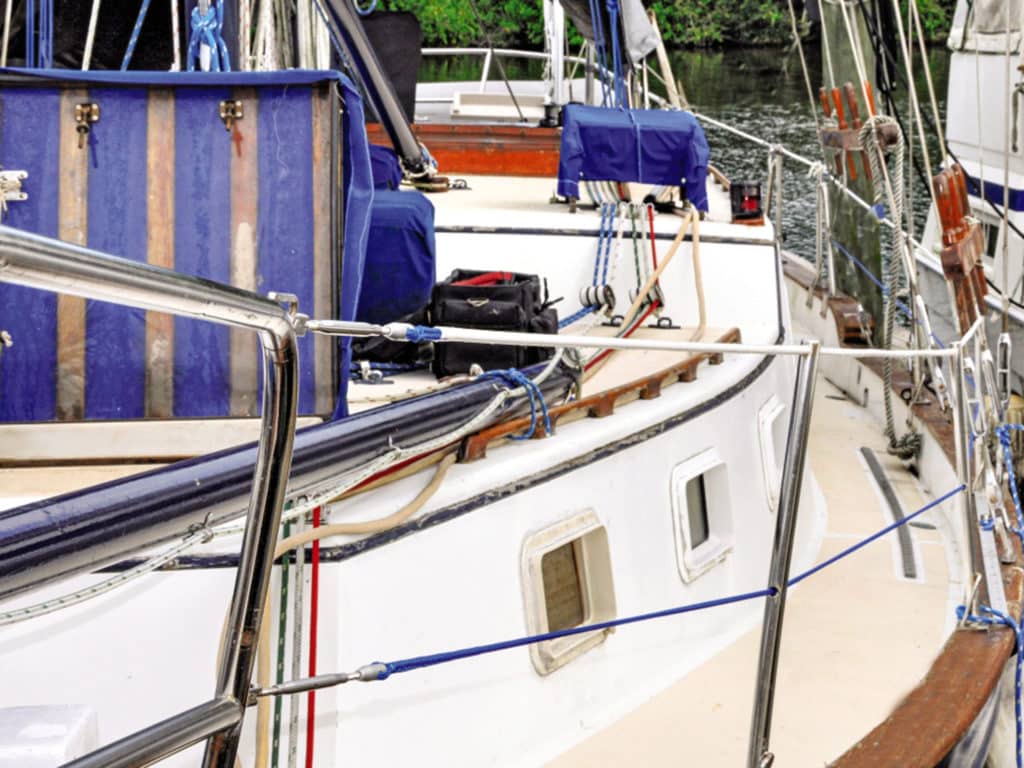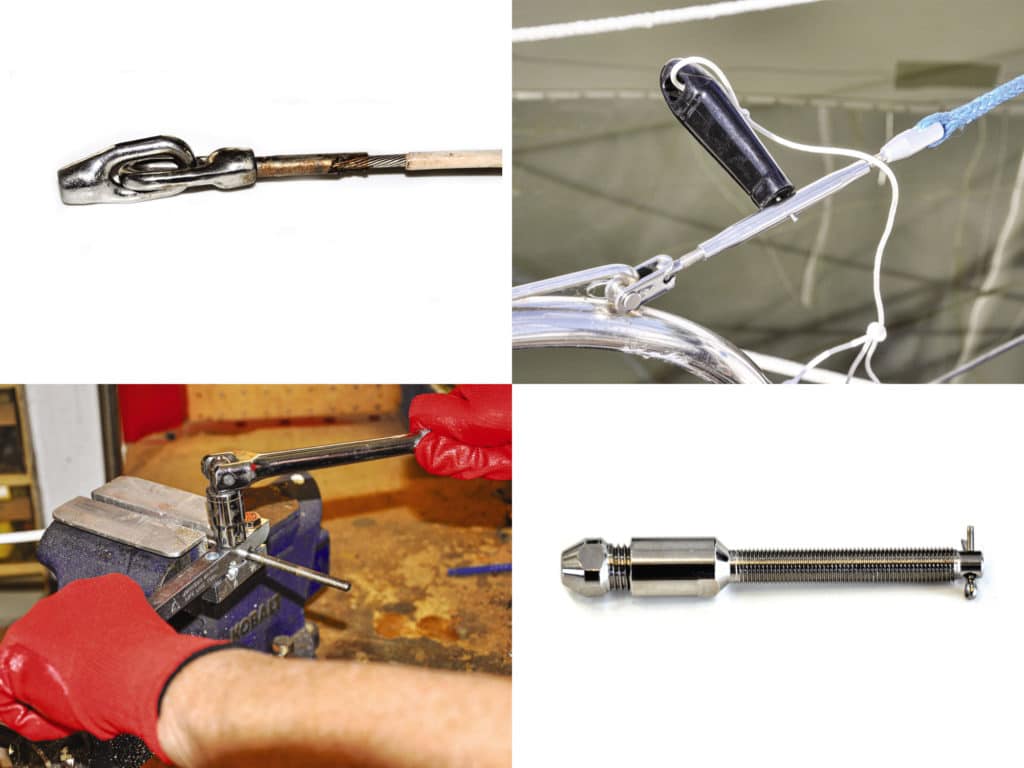
The vinyl-coated wire lifelines on my 1977 Downeaster 45 schooner, Britannia, were well past their prime. Sections of the vinyl coating had faded into a dull brown—with parts chafed and cracked, exposing the wire—and many of the chrome fittings had lost their luster. If I accidentally ran my hand along an exposed section, I’d pierce my fingers. They simply had to be replaced, not only for safety and to restore a smooth surface, but also for the appearance.
Lifelines are intended to stop someone from falling overboard, so that’s the primary consideration in any replacement. But this does raise another important question: How does a person who falls overboard get back on board: through or over the lifelines? I’d once experienced a man-overboard situation where this became an issue, so it was foremost in my thinking.
Most lifelines have pelican hooks at one end that can be released to lower the lines. Britannia’s were the old style, with a locking ring over the release lever. When the wires were tight, it was very difficult to pry the ring back over the latch by hand, and pliers were necessary to squeeze the latch.
A new type of pelican hook, from CS Johnson Inc., has a pin, like a snap shackle, that releases the hook even with the lines under maximum tension. Lines can also be released by unwinding the tensioning turnbuckle toggle at the other end, but if the line is tight, it too can be difficult to do so by hand. I found a neat little adjustment tool at CS Johnson’s website that fits in the center small hole of a tubular turnbuckle and is much better than pliers or a bit of old wire, which I had been using for years.
If for any reason lines cannot be released, a final option would be to cut the wire, which requires long-handled wire cutters for 3/16-inch wire—but what if the lifelines are rope? That would be easy to cut, but would rope be strong enough? Questions, questions.
Wire vs. Rope?
Since I was going to replace the wires anyway, I decided to look at the pros and cons of wire and rope. Maybe there’s a better alternative to old-fashioned wire? Regarding strength, I couldn’t find any manufacturer who gave the strength of their material when used specifically as lifelines. All I could find for both wire and rope was “tensile strength” or “working load.” No account was given for stanchions either, which are integral to any boat’s lifeline system. How stanchions hold up depends on their deck fastenings, length and tube thickness. Whatever I decided to use to replace my worn lifelines, it had to be no thicker than 3/8-inch (10 mm) diameter to pass through the 7/16-inch (11 mm) holes through the stanchions. I started listing the pros and cons:
Uncoated wire can become almost untouchably hot in the Florida summers, where Brittania lives, and I don’t like gripping thin wire with bare hands anyway, so I didn’t want to consider that. Vinyl-coated wire is commonly fitted by manufacturers and sold through aftermarket suppliers. It looks smart when it’s new, but over time, water can enter at the ends and wherever chafe has exposed the wire. Eventually this causes corrosion that might not be visible under the covering. However, wire is strong, and 3/16-inch 7-by-7 strand has a working load of 3,700 pounds. (As an aside, boats with wire lifelines should preferably also have a good quality wire cutter on board to chop the wire in an emergency.)
All that said, Dyneema rope’s working load is stronger, size for size, than stainless wire. The possibility of substituting rope for lifelines therefore becomes a viable possibility. I found Miami Cordage Inc., a rope-maker, hidden in the industrial depths of greater Miami. Most recreational boaters will not have heard of this wonderful Aladdin’s cave of rope because nearly all of its product goes to the United States Navy, Coast Guard and other industrial outlets. Yet they make every conceivable type of rope, from old-style three strand to 12-strand Dyneema, which they call Ironlite. Their prices are considerably less than the regular retail outlets most sailors, including me, regularly use. Their 1/4-inch (6 mm) single-braided 12-strand has an amazing tensile strength of 8,000 pounds.
Once that overview was completed, I started digging deeper by going down a list of several categories.
Cost comparison: 7-by-7 3/16-inch vinyl-coated wire: $1.79 per foot (defender.com); Dyneema Ironlite 1/4-inch 12-strand in blue: $0.60 per foot (miamicordage.com).
End fittings: A significant additional cost in replacing existing lines are the fittings needed on each end, especially if new turnbuckles and pelican hooks are needed.
Stretch (creep): Once tensioned bar-tight with the turnbuckles, wire does not stretch further. Dyneema stretches only about 1 percent, but once stretched, it does not move much after that. Dyneema can also be set up bar-tight.
Chafe: All lifelines are subject to chafe by anything rubbing against them: sheets, dock lines, fender lines and where they pass through stanchions. Britannia’s stanchions have a 7/16-inch-diameter flared tube in each cross-through hole that minimizes chafe at those points.
Cleaning: White vinyl-coated wire can simply be wiped with a rag and some bleach now and then, but the vinyl still fades over time. Dyneema has a shiny, slightly slippery texture that can be cleaned with soap and water.
How to Install
The next item to consider was ease (or lack thereof!) of installation. Once again, I broke it down to the potential materials.
With wire, I needed roughly 150 feet (46 m) with 16 threaded ends to replace my old wire, along with at least three new turnbuckles to replace the jammed old ones. The conventional method of attaching threaded ends to wire is to compress, or swage, the fitting to the wire. This can be done using a hand tool offered by most rigging suppliers ($42 from Defender), but it is tedious if you have a lot to do. First, the vinyl coating has to be cut back a couple of inches, exposing the wire (which in itself is not easy, and best done in a sturdy vice with a sharp box-cutter blade). Then, using a wrench to tighten the bolts on the swaging tool, five crimps are recommended on each fitting. I needed 16 fittings each with five swages—that’s 80 crimps! Even if each swage took only five minutes, it would still take nearly seven hours. Defender has a long-handled crimping tool that makes short work of swaging multiple fittings, but unfortunately the price is $279. Also, hand-swaging produces only 65 percent of the strength of the wire, but a crimping tool increases this to 85 percent.
An alternative method, which does not require swaging or any special tools, are wire Sta-Lok fittings by CS Johnson. These are easily assembled on wire using regular wrenches and actually provide 100 percent of the strength of the wire, and are approved by Lloyd’s of London for lifeline fittings.

As an option to hand-swaging, I decided to ask for a quote from the rigging services of a local marine retailer for vinyl-covered wire with end fittings professionally attached. I needed four 30-foot lengths and four 6-foot lengths. The price was nearly $800 for the wire alone. It was at this juncture that I decided to look seriously at Dyneema.
Rope can be attached to existing toggle end fittings with either a splice or even a knot, but CS Johnson has special rope/end attachments, called Splice-Line lifeline fittings, to attach Dyneema to all types of fittings such as turnbuckles and pelican hooks. The rope is spliced directly around the fitting without a thimble, and chafe is reduced to a minimum.
Single-braid Dyneema is hollow, with no center core, and much easier to eye-splice than double braided line. The 12-strand rope is first tapered by removing four pairs of strands, then the end is buried deep inside the standing part and lock-stitched. This is an easy operation with a special 14-inch-long splicing wand from Brion Toss Yacht Riggers (briontoss.com). This fid enables the tapered end to be gripped by the wand and then pulled through the core, instead of pushing it with a conventional fid. With 16 splices to make, I was very thankful to have one. The fid can also be used for other rope work.
I would need about 200 feet (61 m) of rope, allowing enough for 16 eye splices. I estimated it would still take about three hours to do them all. Miami Cordage makes Ironlite in many colors, including solid blue, which nicely matched Britannia’s royal-blue color scheme.
Advantage Dyneema
For my project and boat, I determined Dyneema was the way to go. Here are some of the reasons why: As mentioned, 1/4-inch Dyneema is much stronger than 3/16-inch wire. Dyneema is not subject to corrosion or affected by rain or seawater, and is easily inspected for chafe.
Any section of a rope lifeline can be lowered easily between stanchions because the line slides through the stanchions and bends easily. Wire does not slide or bend readily. If necessary, rope lifelines can be cut with a sharp knife; wire needs a long-handled wire cutter.
Furthermore, rope lifelines can be replaced in a jiffy, even on a passage. A spare 50-foot length of 1/4-inch Dyneema is much easier to store than the same length of wire.
Dyneema is significantly lighter than wire rope. My complete wire lines weighed 13 pounds. The same length of Dyneema rope weighed only 2.4 pounds. I imagined the weight I’d be saving in my schooner’s 700 feet of 3/8-inch stainless-steel standing rigging—something to think about.
Finally, there was the price difference—150 feet of 3/16-inch vinyl-coated wire, 16 threaded swage ends, plus a hand-swaging tool and wire cutter runs about $650, while 200 feet of 1/4-inch Dyneema, a splicing wand and three new turnbuckles cost $292.
These prices were based on using my existing pelican hooks, turnbuckles and other fittings, but I finally decided to dive in and do the job properly with new parts. I used CS Johnson’s Splice-Line rope fittings, including new turnbuckles and beautifully crafted quick-release pelican hooks, with blue Miami Cordage 1/4-inch Ironlite Dyneema. The whole installation took two weekends to replace all the old lifelines, and I eventually got the timing down to 10 minutes for each Dyneema splice. Practice makes perfect.
There was one final thing I decided to try: Since one of the only things that can weaken Dyneema lines is chafe, I decided to enclose the sections where this might occur with plastic covers that clip completely over the rope and act as chafe guards. These are 6 feet long and only $2 each from West Marine. They still allow the rope to move freely inside and, if any of the guards show signs of chafe, it’s a simple matter to replace one section before it wears the rope itself. They also increase the line thickness to nearly 1/2-inch, which makes holding the lines much more comfortable.
Britannia’sfinished lines now look stylish and purposeful, and I am confident that in the event of a real man-overboard emergency, I will have the least possible obstructions to get the person back on board, past the lines. It’s a win-win solution.
Florida-based sailor and handyman Roger Hughes is overhauling his 45-foot schooner, Britannia, one system and project at a time.








